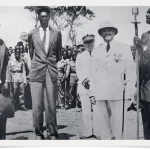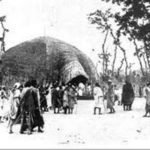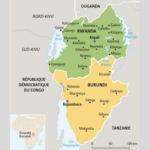Recontextualizing Rwandan Dynastic Chronology
The ideology of kingship asserted that kingship was legitimated by its antiquity: the dynasty was at the heart of Rwandan culture, so the founding of the dynasty must (logically) correspond to the origin of the culture. By one official source, that meant that kingship in Rwanda was formed in 1091 and followed invariable father-to-son succession to 1959. Court sources claimed to substantiate that chronology by drawing on tie-ins linking the Rwandan genealogy to the chronologies of royal lines in neighboring states. But internal evidence casts doubt both on the depth of such a proposed chronology and even on the sovereign status of some of those individuals named in the official Rwandan king list. Analysis of the dynastic histories offour neighboring states only confirms such skepticism; both internal and external evidence suggest quite a different (and much shorter) royal chronology for Rwanda than that presented in the official sources. Based on detailed analysis of the comparative data, this chapter proposes a reassessment of both the chronology and the content of the “official” king list of Rwanda, showing again how historical analysis can apply even to fundamental elements of society—in this case the chronology of kingship.
The Conundrum of Chronology
Chronology used to be an object of great interest among African historians because it was seen as essential to history, it provided exactitude where so much else was interpretive, and it was such a challenging feature to determine from oral accounts. More recently, historical analysis has been concerned more with processes and periods than with defined events and dates. Although deemed to be useful when available, precise chronology is now seen as less essential to historical reconstruction; it is accepted that chronologies are subject to interpretation and debate, and that these debates themselves illuminate the way in which local communities reconstruct—and historians understand— history.
This text addresses such issues of debate, contestation, and negotiation —that is, it explores the nature of intellectual hegemony—but it does so across cultural boundaries. It thus illustrates a fundamental contradiction in the manner by which historians have treated cultural units defined as distinct: while as independent polities they have been assumed to be culturally autonomous, yet source material from one is often drawn on to fill in the gaps of others. This procedure was especially common where there were powerful kingdoms whose political boundaries were assumed to be rigid and inviolate. The states of the western Interlacustrine area, each believed to be ruled by an established dynastic line whose origins reached far back into antiquity, provide an exemplary illustration of this process.
By the early twentieth century, at the time of European conquest, Rwanda was one of the most powerful of these states, having either conquered and absorbed, or at least dominated, many of the distinct kingdoms with which it formerly competed. The political ascendancy of Rwanda was also reflected in its historical luster, for the power that ensured its regional political hegemony also legitimated its historical claims, at least in the eyes of many. Rwandan power also attracted the interest of Europeans; it is not surprising that many of the first written works on the dynastic history of the region focused on Rwandan court traditions. Over time these early attempts were elaborated, consolidated, and standardized, a process culminating in the massive corpus produced from the 1940s by Alexis Kagame, a Rwandan priest. Others studying in this region often came to refer to this work as the validating text, the central historical core to which other histories were compared; among neighboring dynastic histories, each individual chronicle taken in isolation was proven correct only if it conformed to—and thus implicitly confirmed—the official Rwandan texts.
However, a new pattern emerges when these different dynastic histories are viewed not in isolation, each in its own terms relative to Rwanda, but in regional perspective. Within this framework, certain patterns emerge: in every case we know of, the dynastic genealogies of states outside Rwanda are shorter than the official Rwandan chronology and by approximately the same amount. Furthermore, where these are known to have been revised, in every case they were lengthened—with the Rwandan dynastic history as the validating factor for its extension. In other words, when looked at within a regional perspective, the Rwandan line becomes itself an exception to the general pattern, rather than its exemplar. To explore this issue, therefore, is to inquire into the transfer of knowledge, to reflect on intellectual authority in a contested field, and to seek out the forces that serve to create knowledge by validating our understanding of a given historical “fact.” In this case, it is specifically to inquire into the authority of the official Rwandan dynastic list over competing interpretations. It reflects the fact that struggle for political autonomy is also a struggle over defining historical legitimacy.
Without engaging in a full examination of the development, elaboration and legitimation of the Rwandan royal chronicle, I seek simply to open up new questions by looking at elements of the regional patterns of dynastic histories common to the region and to indicate aspects of the Rwandan dynastic history that are suggestive of how this process of elaboration and legitimation took place. This inquiry builds on the work of others who have engaged with these questions before. But rather than suggesting slight adjustments to the official texts, refining the currently accepted dynastic history (and chronology) as currently accepted, I focus on larger issues based on regional perspectives, not isolated chronologies. I do not arrive at assured conclusions; this inquiry thus reflects the nature of oral knowledge and oral discourse. We may have to be satisfied with articulating the debates rather than resolving them, with identifying the issues of contention rather than arriving at a single consolidated, definitive account.
The argument suggests that looking carefully at materials drawn from outside the confines of the central court of Rwanda will lead to a reexamination of the published sources on the Rwandan king list. I will first examine four cases of states neighboring Rwanda: Gisaka to the southeast, Ndorwa to the northeast, Burundi to the south, and Buhavu to the west. In each of these instances, the written chronicle of the dynastic line appears to have been altered to correspond to the imputed chronology of Rwanda. However, I am not interested simply in reconstructing the chronologies. Instead, the common pattern to emerge from such asurvey suggests that the Rwandan king list and its associated chronology need to be radically rethought. Doing so in turn leads me to examine elements in the Rwandan dynastic chronicles that bear on this revisualized chronology. In particular, I will focus on a single cycle of four king names, the cycle immediately following Ruganzu Ndori and preceding Cyilima Rujugira.
Gisaka and Rwanda: The Dynastic Tie-Ins
Early writings on Rwanda noted only a few kings, without fixed order.It was not until the work of Alexis Kagame in the 1940s and 1950s that the published dynastic chronicles assumed their grandest forms. Since that time, the Rwandan royal history has been celebrated for its precision, its comprehensive character, and its antiquity; and in the eyes of many commentators, greater precision and greater antiquity ipso facto implied greater legitimacy. Because the comprehensive nature of the Rwandan chronicles included many references to the dynastic lines of neighboring kingdoms, the greater antiquity and greater perceived validity of the Rwandan line resulted in a lengthening of the royal histories of neighboring states.
The most explicit example of this process is that of the king list of Gisaka, a region in southeast Rwanda incorporated into the Rwandan state at intervals over the course of the later nineteenth and early twentieth centuries (and in the end, with German and Belgian assistance). The major chronicler for this kingdom is A. d’Arianoff, whose Histoire des Bagesera serves as the principal precolonial source for this area. Early king lists counted eight or nine names back from Kimenyi Getura, who reigned early in the nineteenth century’s. But of those names, only six were consistent among the three extant king lists. D’Arianoff explained such divergence not in terms of differential perspectives (the process of uneven regional expansion, or differential class incorporation to Gisaka royal structures), but by the tendency of informants to alter their testimony to please—or deceive—the listener. Rwandan court sources, he averred, were more reliable because they contained formal checks assuring the validity of the information transmitted. And so d’Arianoff sought recourse to Kagame.
Although he had never set foot in Gisaka, Kagame not only confirmed d’Arianoff’s list, but extended it. He claimed that the name of Kimenyi recurred several times within the Gisaka king list, but that local sources (or those who recorded them) had omitted the replications. In essence, then, Kagame retained d’Arianoff’s list, the longest of the three available, but inserted two more kings named Kimenyi, so that this dynastic name not only appeared as the first and last names on the list, but at quasi-regular intervals as well. As a result of Kagame’s intervention, d’Arianoff felt able to assert: “Rwandan sources establish with certainty the existence of four kings with the name of Kimenyi, although Kisaka elders account for only two.”Such was the authority of Kagame.
Justification for this assurance was found in four tie-ins between the Rwanda and Gisaka ruling lines. Two consisted of marriage alliances—one very early, the other very late in the Gisaka list. In the first case, Robwa, the sister of Ruganzu Bwimba (the first “historically validated” Rwandan king; r. 1312–45 by Kagame’s chronology) is said to have married Kimenyi, king of Gisaka. She is remembered in Rwandan traditions because, on hearing that her brother had been killed onthe field of battle against Gisaka, she killed herself. Her unborn child, the prospective heir to the Gisaka throne, died with her; according to the Rwandan augurs at the time, this child, had he grown to maturity, would eventually have overthrown the Rwandan dynasty. Thus, according to this interpretation, her action saved the Rwandan state at the moment when her own brother had died in battle against Gisaka.The second case occurred in the penultimate reign of the Gisaka dynastic list, when the cousin of Bazimya is said to have married Cyilima Rujugira (r. 1740–60by Kagame’s chronology).
Between these two marriage ties, for over two centuries, the Gisaka traditions presented by d’Arianoff add little: the two added kings named Kimenyi are known only by recourse to Kagame’s Rwandan chronicles, where each is noted with a tie-in to a Rwandan king, the first to Mibambwe Mutabazi, the second to Kigeri Nyamuheshera.It is almost as if the Gisaka list has been extended to fit the tie-ins … Such an appearance is even stronger when it is noted that this re-vised list for the Gisaka kings, validated only by the Rwandan tie-ins, is said to include eleven kings over four centuries—that is to say, almost a forty-year aver-age maintained over four hundred years.
Yet, skepticism aside, the authority of the Rwandan priest who was also privy to Rwandan esoteric traditions—the historian who was also a member of one of the elite families of late nineteenth-century Rwanda—was immense.” D’Arianoff notes that “the remarkable work of classifying, unifying, and interpreting the diverse data undertaken by Abbé Kagame has spared me much laborious research, and made it possible to compare easily the results of our fieldwork with the indications—few but sure—on the early history of Gisaka accounted for in Rwandan sources.”And he goes on to add, apparently without irony, “May we express here our heartfelt thanks to Abbé Kagame for his disinterested support offered in both information and advice.”d’Arianoff is thus explicit both about his debts and about the way in which he “rectified” the deficient Bagesera king list—by placing the Bagesera line in conformity with the Rwandan line and adding the requisite kings to the list.
Ndorwa and Rwanda: Cyclic Traditions
A similar, though more sophisticated, process of alignment occurred for Ndorwa, a kingdom associated with a Bashambo dynasty northeast of the Rwandan heartland. Here Freedman presents a most interesting example of recycling king names.
But they are once again premised on the assumption that they must coincide with the Rwandan king list and that the Rwandan line as given by Kagame is correct.
For this area Freedman notes diverse and incompatible local traditions associated with the names Gahaya and Murari; he suggests that these incompatibilities result from references to different individuals bearing the same name. As support he notes that one Gahaya was a contemporary of Rujugira in Rwanda, and he cites Kagame. But Gahaya was also the name of the ruler at the time of Ndorwa’s grandeur, which apparently occurred four Rwandan reigns earlier, at the time of Kigeri Nyamuheshera; the source—Alexis Kagame. Accepting these references to two different—and widely separated—Rwandan kings, Freedman postulates that these references actually refer to two distinct individuals sharing a common dynastic name. Noting that the pattern of recurring dynastic names appears frequently in the region (and citing the examples of Nkore, Gisaka, and Rwanda, the last two based on Kagame), Freedman concludes that it is only reasonable that the Bashambo of Ndorwa should also have designated their kings according to a repeating cycle of names…. With this in mind, many of the anomalies of the history of Ndorwa begin to dissolve.”
His analysis builds on these premises, stated as established facts: “Assuming that as in the other Interlacustrine kingdoms, the names in the dynasty of the Bashambo-ruled kingdom recurred, one may begin to inquire how the cycles of kingship merge with the historical facts available.”However, two aspects to this argument are worthy of note. First, dynastic names are assumed to recur in all (“the,” not “some”) Interlacustrine kingdoms. In addition, this feature of repeating dynastic names becomes transformed to a “cycle” (or a recurring pattern) of kingship names; in fact, very few kingdoms adhered to such a cyclical pattern. But even with these arguments, not all the anomalies dissolve. Freedman notes that “there are considerable gaps in the [newly constructed] chronology, periods when no kings at all are mentioned.”Yet these gaps appear only “in comparison to the ruling genealogy of Rwanda.”
It is an elegant and sophisticated analysis, based on intimate familiarity with the sources, both local and published. Indeed, I am not arguing here against the appearance of common names in a king list, or even against repeating cycles of names, as a principle in itself. These characteristics can, and do, occur, although not in all states. Nor am I arguing against the utility of comparative analysis in historical reconstruction. Nonetheless, such analytic techniques need to conform to the canons of historical analysis, which include attention to the sources and especially to the independent provenance of data to be compared. To prove one set of data by reference to another set derived from the first is to engage in tautological thinking: if one draws on Rwandan data to reconstruct the Ndorwa king list, one cannot prove its validity by reference to the Rwandan king list. The events in question could well have occurred, but such reasoning does not establish that they did.
What is striking in this case is the recurring pattern of such a process: in Ndorwa as in Gisaka, in Burundi as in Buhavu, the same pattern appears to hold. In each case the chronology is established—and the king list lengthened—by reference to Rwanda; the gaps are filled in with recurring names (or recurring cycles); and the Rwandan chronology is then implicitly validated by the convergence of neighboring dynastic genealogies which then appear to correspond to—and thus to confirm—the Rwandan core chronology.
https://uk.amateka.net/recontextualizing-rwandan-dynastic-chronology/https://uk.amateka.net/wp-content/uploads/2020/04/church6.jpghttps://uk.amateka.net/wp-content/uploads/2020/04/church6-150x150.jpgHistory of kingsSocial & cultureThe ideology of kingship asserted that kingship was legitimated by its antiquity: the dynasty was at the heart of Rwandan culture, so the founding of the dynasty must (logically) correspond to the origin of the culture. By one official source, that meant that kingship in Rwanda was formed in...BarataBarata rpierre@ikaze.netAdministratorAMATEKA | HISTORY OF RWANDA



